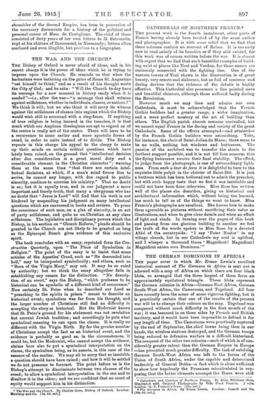CATHEDRALS OF NORTHERN FRANCE. 0 THE present work is the fourth
instalment, other parts of France having already been treated of by the same author and photographer. It is with some relief that we find that these volumes contain no account of Reims. It is too early now to read calmly of its beauties as if they still existed, for this work was of course written before the war. It is almost with regret that we find that such beautiful examples of build- ing exist at places like Toni and Verdun, for these names are ominously connected with the fighting line. One of the western towers of Toni shown in the illustration is of great beauty, very ornate and elaborate, but so full of resource and daring devices that the richness of the details is highly effective. This Cathedral also possesses a fine pointed nave and beautiful cloisters, although these suffered badly during the Revolution.
However much we may 'love and admire our own Cathedrals, it must be acknowledged that the French Gothic builders had a greater range, a wider imagination, and a more perfect mastery of the art of building than others. The English parish church remains unrivalled, but we cannot equal France in the daring and variety of the great Cathedrals. Some of the effects attempted—and attained— by the French Gothic builders were astonishing. Take, for instance, the choir of Saint-Julien du Mans ; there seem to be no walls, nothing but windows and buttresses. The passion of the architect was to transfer the strain to the furthest support possible, and it is not till four removes that the flying buttresses receive their final stability. The effect, to judge from the photograph, is one of extraordinary light- ness. From such a tour de force it is delightful to turn to the exquisite little pulpit in the cloister of Saint-Die. It is just a buttress which has been hollowed out to admit the preacher, but with such happy taste that we feel it was inevitable and could not have been done otherwise. Miss Rose has written well of the places she describes, giving us historical and architectural information which, without being too learned, has much to tell us of the things we want to know. Miss Francis's photographs are excellent. She knows how to make them agreeable as pictures without sacrificing their value as illustrations, and when to give clear details and when an effect of light and shade. In turning over the pages of this book and passing from one glorious building to another we feel the truth of the words spoken to Mies Rose by a devoted Abbe of the countryside "I say 'Pater Nester' in my village church, but in our Cathedrals my soul is uplifted, and I whisper a thousand times ' Magnificat! Magnificat Magnificat anima me& Dominum."














































 Previous page
Previous page